Rubik's cube - Edge Rotations - Details
Method 1 for rotating 2 edges
| Initial formula |
rotated by 1 |
rotated by 4 |
Variant |
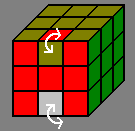
| 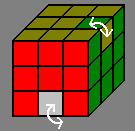
| 
| 
|
-T
R
T
F
R2
-F
2R -R
F
-R2
-F
-T
-R
T
-2R R
|
R
T
F
R2
-F
2R -R
F
-R2
-F
-T
-R
T
-2R R
-T
|
R2
-F
2R -R
F
-R2
-F
-T
-R
T
-2R R
-T
R
T
F
| -T
R
T
F
R2
-F
2R2 -R2
F
-R2
-F
-T
-R
T
-2R2 R2
|
In this method, we first rotate one edge in 6 moves (in orange) while making sure that nothing else in the middle slice (between right and left faces) has changed. then we replace that edge by a different edge (white moves), and undo the first set of 6 moves (in cyan), and we restore the middle slice (white moves).
The 2nd and 3rd formulas show that by "rotating" a formula, we can end-up affecting different cublets.
Method 2 for rotating 2 edges
| Initial formula |
rotated by x |
rotated by y |
rotated by z |

| 
| 
| 
|
-F
-R
F
-2R R
-F
R
F
D
R2
-D
2R -R
D
R2
-D
|
|
|
|
This method is based on the exchange of 3 edges (in white) followed by another exchange (in orange) of the same 3 pieces. Because the 2nd exchange swaps the pieces back into the same place with a different formula, it results in rotating 2 pieces.
Also, those 2 formulas normally have 10 moves each, but they were chosen so that the last 2 moves of the 1st formula and the first 2 moves of the second cancel each other, to result in a 16 move formula.
Method 3 for rotating 2 edges
| Initial formula |
variant 1 |
variant 2 |
variant 3 |
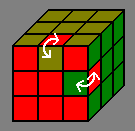
| 
| 
| 
|
-T
-2B B
T2
-2B2 B2
-T
-F
T
-2B2 B2
T2
2B -B
T
F
| -T
-2B B
T2
-2B2 B2
-T
F2
T
-2B2 B2
T2
2B -B
T
F2
|
|
|
In this method, we first rotate one edge in 6 moves (in orange) while making sure that nothing else in the front face has changed. then we replace that edge by a different edge (white move), and undo the first set of 6 moves (in cyan), and we restore the front face back in place (white move).
rotating 4 edges
| Same face |
Same slice |
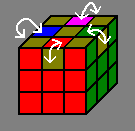
| 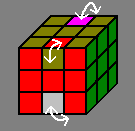
|
R
-B
-R
B
-T
B
T
-2B
2R -R
B
-T
-B
T
-B
R
B
-2R
2B -B
| -T
-F
R2
F
T
-R
D
F
R2
-F
-D
2R2 R2
D
F
R2
-F
-D
R
-T
-F
R2
F
T
-2R2 R2
|
3 sides
20 moves |
4 sides
26 moves |
The first formula is based on an 8 move formula that rotates 2 edges on one side. Then the 2 edges are replaced by 2 other edges, and the 8 moves formula is made backward. Once simplified, it turns into a 20 move formula.
The second formula is based on the same principle than the first formula to rotate 2 edges. Once rotated, they are exchanged with 2 other edges on the same slice, then the initial formula is made backward.
Rotating 6 edges
| First formula |
Second formula |

| 
|
R
2T
R
2T
R
2T
R
2T
R
T
R
2T
R
2T
R
2T
R
2T
R
T
R
2T
R
2T
R
2T
R
2T
R
T
| -F
-T
F
T
-F
-T
F
T
-F
-T
F
-2F
T
2F
-T
-2F
T
2F
-T
-2F
T
2F
|
2 sides
30 moves |
2 sides
22 moves |
The first formula is probably better for rotating all edges, but they are both too long. I'm working on finding more efficient formulas.
Rotating 8 edges
| First formula |
Second formula |
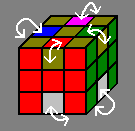
| 
|
2R -R
2B -B
T2
2R -R
2B -B
T2
F2
R2
F2
R2
F2
2R R
2B -B
| 2R R
-2B -B
2R R
-2B -B
2R R
-2B -B
|
4 sides
19 moves |
2 sides
12 moves |
I first discovered the 19 move forumula, and later, trying to find a formula for 4 edges, I found the 12 move formula for 8 edges.
Note: the formula that rotates 8 edges in 19 moves also rotates Front and Bottom centers 180°.
Click here if you need to understand the notation used on this page















